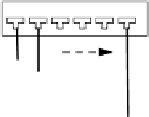Information Technology Reference
In-Depth Information
26.8 Twisted-pair hubs
Twisted-pair Ethernet (10BASE-T) nodes normally connect to the backbone using a hub, as
illustrated in Figure 26
.12.
Connection to the twisted-pair cable is via an RJ-45 connector.
The connection to the backbone can either be to thin or thick Ethernet. Hubs are also stack-
able, with one hub connected to another. This leads to concentrated area networks (CANs)
and limits the amount of traffic on the backbone. Twisted-pair hubs normally improve net-
work performance.
10BASE-T uses two twisted-pair cables, one for transmit and one for receive. A collision
occurs when the node (or hub) detects that it is receiving data when it is currently transmit-
ting data.
Ethernet backbone
10BASE-T
hub
Figure 26.12
10BASE-T connection
26.9 100 Mbps Ethernet
Standard 10 Mbps Ethernet does not perform well when many users are running multimedia
applications. Two improvements to the standard are Fast Ethernet and 100VG-AnyLAN. The
IEEE has defined standards for both of them, IEEE 802.3u for Fast Ethernet and 802.12 for
100VG-AnyLAN. They are supported by many manufacturers and use bit rates of 100 Mbps.
This gives at least 10 times the performance of standard Ethernet.
New standards relating to 100 Mbps Ethernet are now becoming popular:
•
100BASE-TX (twisted-pair) - which uses 100 Mbps over two pairs of Cat-5 UTP cable
or two pairs of Type 1 STP cable.
•
100BASE-T4 (twisted-pair) - which is the physical layer standard for 100 Mbps over
Cat-3, Cat-4 or Cat-5 UTP.
•
100VG-AnyLAN (twisted-pair) - which uses 100 Mbps over two pairs of Cat-5 UTP
cable or two pairs of Type 1 STP cable.












































